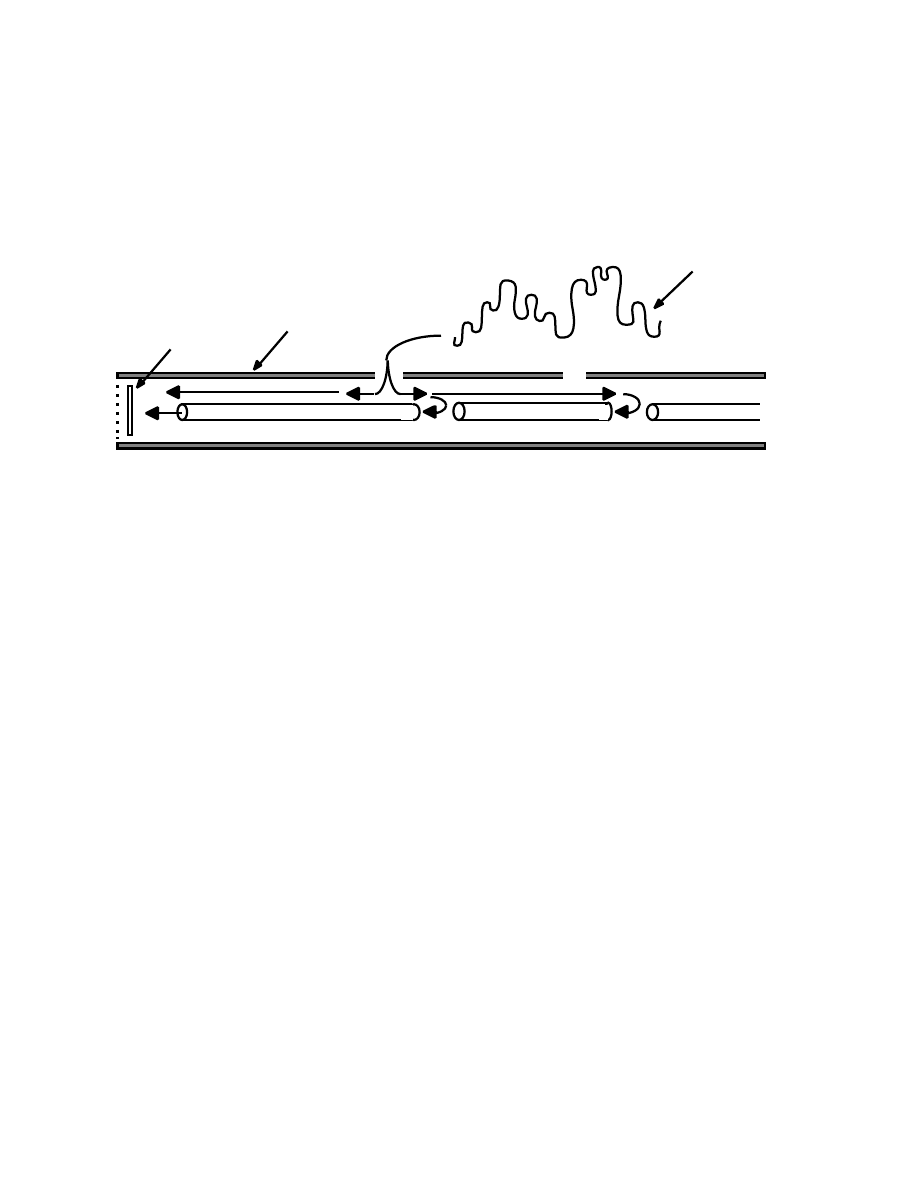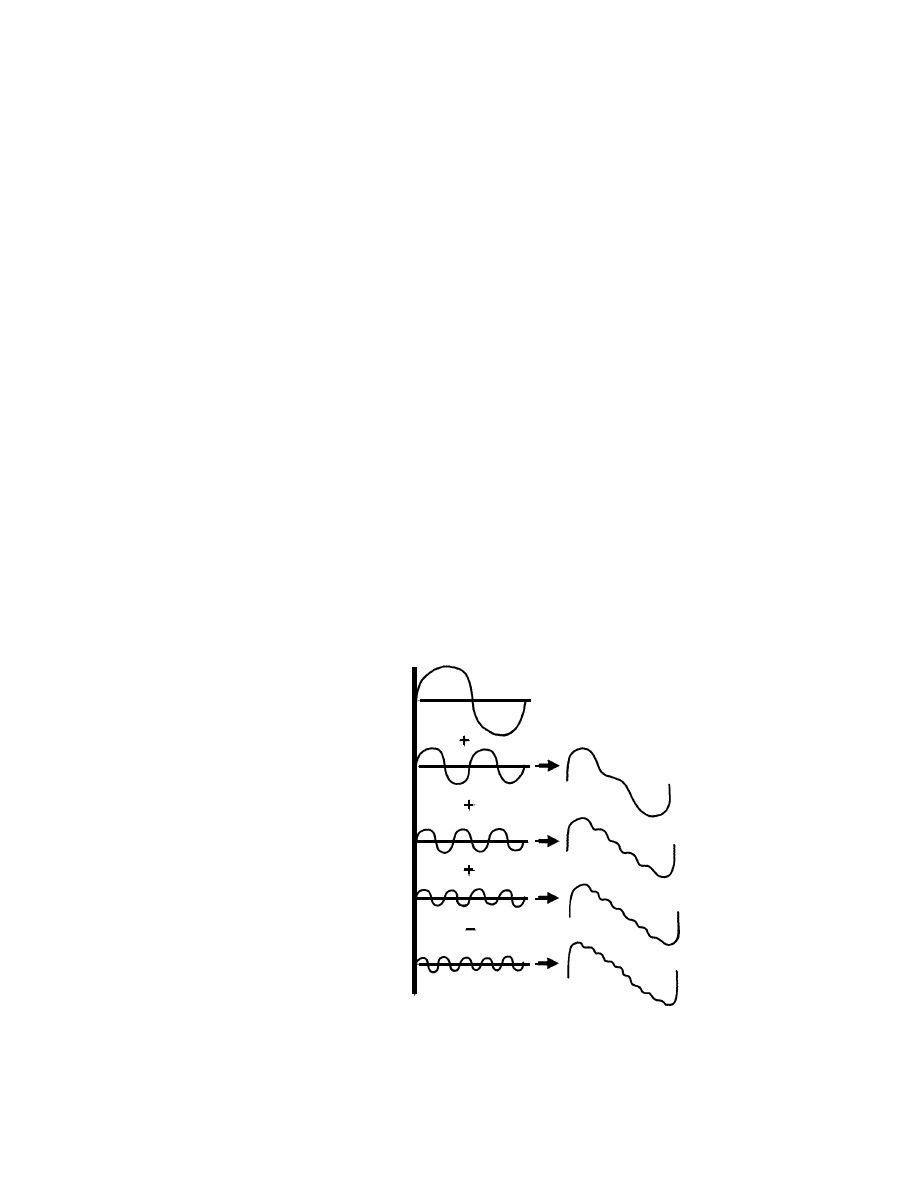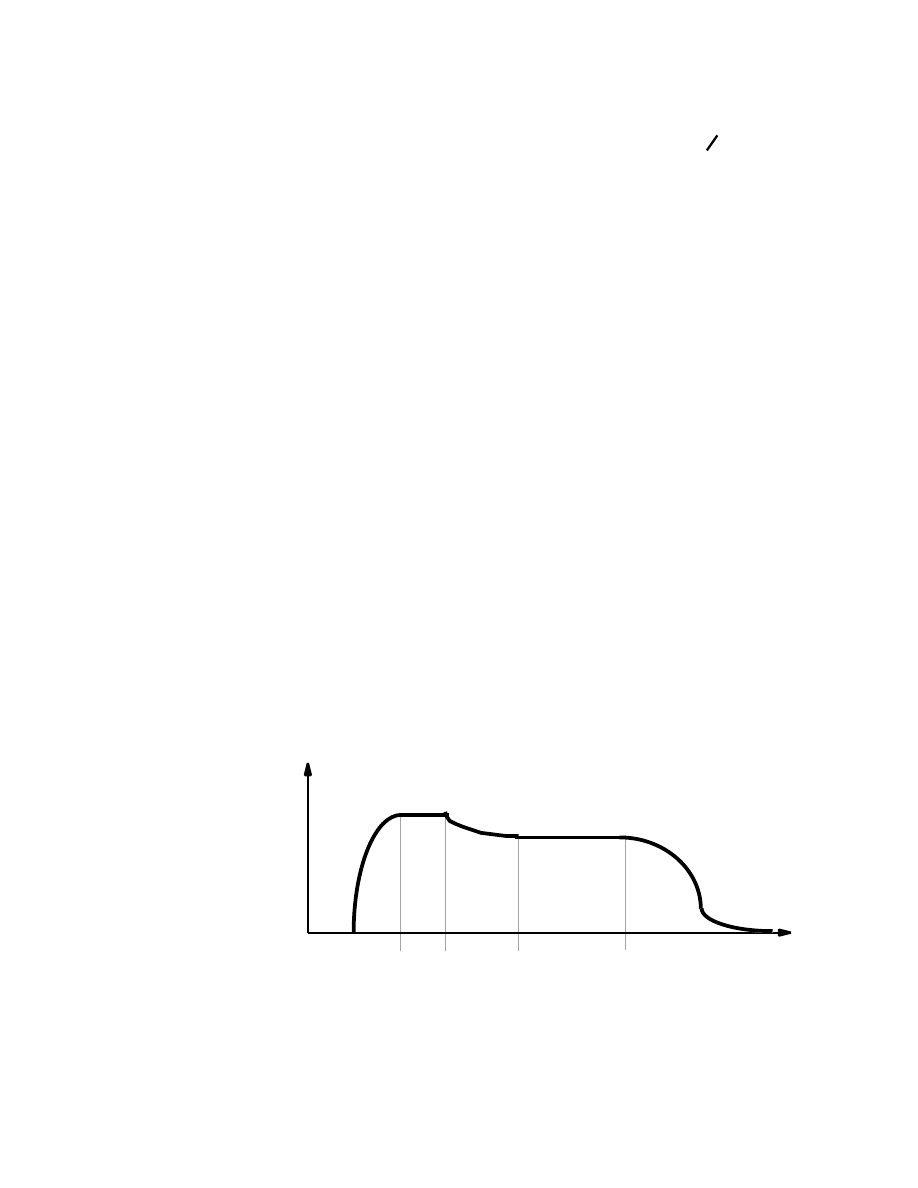ВУЗ: Казахская Национальная Академия Искусств им. Т. Жургенова
Категория: Учебное пособие
Дисциплина: Не указана
Добавлен: 03.02.2019
Просмотров: 12497
Скачиваний: 6

A
acoustic labyrinth: (1) A type of design for the housing of highly directional microphones that
enhances the rejection of off-axis sources. Two or more concentric tubes in front of (and some-
times around) the capsule create a compact series of folded pathways through which all
sounds approach the diaphragm. Those arriving on-axis reach the capsule via these paths in
phase coherence. Off-axis sounds, due to the different lengths of the passways, reach the dia-
phragm and are partially or fully removed due to phase cancellation.
Diaphragm
Sound
Acoustic Labyrinth
Sound entering from sides and rear arrive out-of-phase
Microphone
Capsule
(2) A type of speaker enclosure in which sound waves emanating from the rear of the woofer
cone travel through a long, folded interior path before coupling with the outside. This ex-
tends bass response considerably.
acoustic lens: A device placed in front of a high-frequency speaker that disperses or directs
the sound in a desired pattern. Normally used to increase the angle of dispersion, either
horizontally, vertically, or both.
acoustic suspension: A loudspeaker designed for, or used in, a sealed enclosure. Typically, a
low-frequency loudspeaker baffle where most of the damping of the cone is the result of the
elasticity of the air in the sealed cabinet.
acoustics: The science or study of sound and its interaction with the human hearing mecha-
nism.
active: (1) An audio device which requires a power source such as from an AC line or bat-
tery, as opposed to passive. Sometimes amplifying components such as transistors or ICs are
called active circuit elements. (2) See MIDI patchbay.
active crossover: See crossover network.
active equalizer: An equalizer that employs active components such as transistors or ICs in
its processing circuits. A pre-amplifying circuit generally follows each stage of actual equali-
zation, boosting the signal level to restore unity gain. See also passive equalizer.
active monitor: A type of loudspeaker which has amplification circuitry built-in. In addi-
tion, a true active monitor system utilizes active equalization and active crossovers to pre-
cisely contour the system sound. If there is only one amplifier driving all transducers,
and/or there is no active equalization or crossover circuitry, the terms powered speaker or pow-
ered monitor are more correct.

A
active sensing: A MIDI system message that carries no note data or control instructions, but
simply indicates to a receiving device that the MIDI line is in working order.
A/D: See analog-to-digital converter.
adagio: A slow or leisurely tempo: 66-76 bpm.
A-DAM: Akai Digital Audio Multitrack. A format developed by Akai in 1987 for recording
twelve tracks of digital audio data on a standard Video-8 cassette and which allows the syn-
chronization of multiple decks for 24- or 36-track recording. The tape runs at four times the
normal Video-8 speed and gives about 15 minutes of recording time at 44.1kHz.
ADAT: Alesis Digital Audio Tape. A second-generation (1992) MDM. Like the Tascam DA-
88, ADAT systems record digital audio on consumer videocasette formats and provide for
interlocking up to 16 8-track, rack-mount recorders in sample-accurate (48kHz) sync for up to
128-track recording. ADAT is a 16-bit format, currently supported as well by Panasonic, us-
ing T-180 S-VHS tape. ADAT-II is a newly proposed 20-bit S-VHS format used by newer
Alesis and Studer 8-track recorders. See also DTRS.
ADB: Apple Desktop Bus. The original serial interface for the keyboard, mouse, and other
“desktop” peripherals on Apple computers. ADB has recently been replaced by USB.
ADC: See analog-to-digital converter.
additive synthesis: The generation of complex musical waveforms in electronic synthesizers
by the linear addition of sine wave components whose frequency relationship is a harmonic se-
ries. See sample synthesis, sound synthesis, subtractive synthesis.
Fundamental
Frequency (1f)
100% amplitude
Second
Harmonic (2f)
50% amplitude
Third
Harmonic (3f)
33% amplitude
Fourth
Harmonic (4f)
25% amplitude
Fifth
Harmonic (5f)
20% amplitude
The Making of a Complex Waveform

A
address track: A control/timing track on the edge of videotape (1”, C, and
3
4
” formats) that
contains control data for quick and accurate location of program material, recorded at the
same time as the picture. See control track.
adjustable turnover: A variable tone control in a preamplifier which allows the adjustment
of the boost/cut and the frequency below or above which the gain/attenuation is applied
(turnover), but not the rolloff slope of the shelving equalizer; if it were possible to adjust the rol-
loff slope, the result would be a fully parametric tone control.
ADPCM: Adaptive Delta (Differential) Pulse Code Modulation. A type of split-band, time-
domain audio compression algorithm for 16-bit digital audio based on describing level differ-
ences between adjacent samples. Different from conventional linear PCM by coding only
level differences between samples, rather than the absolute level of each sample. According
to the characteristics of the audio signal, ADPCM adapts the step size represented by each
quantizing interval to accommodate rapid changes in level caused by high frequencies or
transients, thereby providing an overall reduction in bit rate; the compression ratio is 4:1.
There are at least two ADPCM standards: Microsoft and IMA/ADPCM, the latter popular
for multimedia applications. See delta modulation, split-band, sub-band, transform coding.
ADR: Automatic Dialogue Replacement. Recording of dialog for a scene after it has been
shot, usually to replace location sound that is unusable because of street noise, camera noise,
etc. The workprint and magnetic film transfer for the scene are spliced into continuous loops
and projected in a sound studio so that the actors can recreate the phrasing and feeling they
had on the set. New takes are recorded on a separate mag film loop and/or other synchro-
nous tape until an acceptable performance is obtained. Virgin looping is the process of re-
cording onto a blank piece of mag film which would later be manually synced to the picture.
Also known as looping. See lip sync.
ADSR: Attack/Decay/Sustain/Release, the four segments of a common type of sound syn-
thesizer envelope. The controls for these four parameters determine the duration (or in the case
of sustain, the height) of the segments of the envelope. Two additional parameters, D (Delay
Time) and H (Hold Time) are available on some synthesizers. See envelope, envelope generator.
Signal Amplitude
Attack
Time
Decay
Time
Sustain Time
Release Time
D
AHDSR
Hold
Time
Delay
Time
ADT: Auto Double Tracking. An effect produced by taking a track and copying the material
onto another track, delayed by a few ms, then mixing it with the original. Like chorusing, but
with a shorter delay. See also double-tracking.

A
AES: Audio Engineering Society. The professional organization whose members report on
new technological developments in audio, and bring together designers, manufacturers, and
users of various audio equipment to establish international standards.
AES/EBU: Audio Engineering Society/European Broadcast Union. A standard for encoding
multiple channels of digital audio along a serial cable, officially named AES3-1985. The stan-
dard specifies 3-pin XLR jacks and balanced line cables, usually running at +4dBm. Origi-
nally designed as a self-clocking system, a subsequent addendum to the specification permit-
ted master clock systems. Two channels of digital audio data are multiplexed on a single con-
ductor within the cable, with a maximum bit depth of 24 bits. Data are transmitted at 64
times the sample rate, allowing the possibility of sending two channels of 24-bit audio (plus
ECC) to play the resulting stereo signal in real-time. AES/EBU does not carry the SCMS copy
code. It has been adopted by the EIAJ, which calls it the CP-340, Type 1. See also S/PDIF.
AES/EBU null clock: See null clock.
AF: Audio Frequency. Means having frequencies within the audible range, usually taken to
be 20Hz-20kHz. This frequency range is an average; many people hear tones below 20Hz,
although most people are virtually deaf above 15kHz or 16kHz.
AFM: (1) Audio Frequency Modulation. A processing scheme used for recording high-
quality analog audio in videocassette recorders equipped with “Hi-fi” stereo audio. (2)
American Federation of Musicians. The union that represents professional musicians in all
their client and employer relations.
after-fade listen: See post-fade listen.
aftertouch: A type of MIDI controller data, generated by pressing down on one or more keys
after they have reached and are resting on the keybed. Also called pressure. See channel pres-
sure, poly pressure.
AFTRA: American Federation of Television and Radio Artists.
AGAC: American Guild of Authors and Composers. A third performing rights organization
similar to ASCAP and BMI but much smaller. AGAC primarily represents modern classical
composers.
AGC: See AVC.
aharmonic: See inharmonic.
AIFF: Audio Interchange File Format. A common Macintosh audio file format. It can be
mono or stereo, at sampling rates up to 48kHz. AIFF files are QuickTime-compatible and
support uncompressed mono, stereo, and multichannel audio at many different resolutions
and sampling rates, including the CD standard. It was designed to serve as a universal inter-
change format that allows any program to open a digital recording created by any other pro-
gram. AIFF is high-quality audio, used in pro-level Mac and PC audio software. As AIFF is
a standard for uncompressed audio, Apple introduced AIFF-C which can use MACE and
IMA/ADPCM compression with ratios as high as 6:1, but the audio sound quality suffers.
AIM: Amplitude Intermodulation Distortion. Intermodulation distortion where one signal will
cause amplitude modulation of another signal.

A
A.I.R.: Always In Record. The practice in a recording session to record virtually everything
on the off-chance that something which was not formally recorded as a take will be useful.
airline version: A remixed and possibly re-edited version of a film that has any objectionable
material removed. The airline film standard is more stringent even than those of the
broadcast networks, and is often used as a benchmark for TV viewing.
air suspension: An acoustic suspension loudspeaker.
algorithmic composition: A type of composition in which the large outlines of the piece, or
the procedures to be used in generating it, are determined by the human composer while
some details, such as notes or rhythms, are created by a computer program.
alias: A file on a Mac that serves as a pointer to another file. The most common use for an
alias is to sit on a desktop or in a top-level folder, where the real document or application file
is nested deep within the file system. This is similar to a shortcut file on a PC-type computer.
aliasing: Distortion that is produced when higher harmonic components of the input audio
signal sampled by a digital recording device, or generated within a digital sound source, lie
above the Nyquist frequency. This happens when the sampling rate is less than twice the fre-
quency of the signal being sampled. The effects of aliasing differ from some other types of
distortion in that its pitch changes radically when the pitch of the intended sound changes.
Also called foldover. See anti-aliasing filter.
alignment: (1) In tape recording, the process of adjusting all parameters of the position and
orientaton of the tape heads and guides with respect to the tape path. See azimuth. (2) The
adjustment or calibration of any parameter of an electronic circuit or device, e.g., program
level, bias level, to bring this parameter into conformance with an industry standard. (3) The
process of matching mixer and recorder meters so that only one meter needs to be watched
during recording. When the mixer and (analog) recorder are both peaking about 0VU, this
minimizes the noise and distortion in both units. Ideally, both units would be matched with
a steady tone (the C or B two octaves above middle-C, or about 2kHz, for example.) See line-
up tone.
alignment recording: See biased noise.
alla breve: A term historically related to mediæval note lengths, in which the breve was one
of the shortest notes. In modern usage, the term is usually used to denote
2
2
(cut-time). In
commercial and popular music, it is frequently used to mean half time, i.e., play twice as fast.
See time signature.
allegro: A lively to reasonably fast tempo: 116-150 bpm. Allegretto is a slightly slower tempo
than allegro.
All-Notes-Off: A MIDI command, recognized by some but not all synthesizers and sound
modules, that causes any notes that are currently sounding to be shut off. The panic button on
a synth or sequencer usually transmits All-Notes-Off messages on all 16 MIDI channels.
all-pass filter: See all-pass network.